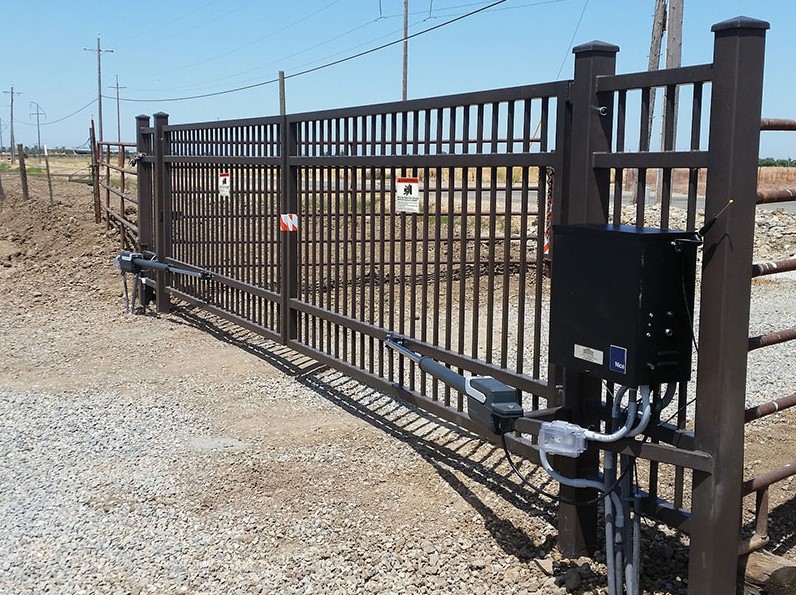As industrial facilities face increasing security challenges, the importance of effective gate security features cannot be overstated. Industrial sites, such as manufacturing plants, warehouses, and chemical facilities, often house valuable assets, sensitive information, and hazardous materials, making them prime targets for theft, vandalism, and unauthorized access. This article explores the essential gate security features tailored for industrial sites, highlighting their significance and how they contribute to a comprehensive security strategy.
Understanding the Importance of Gate Security

Gate security serves as the first line of defense for industrial sites. A well-designed gate security system not only deters potential intruders but also ensures that authorized personnel can access the site safely and efficiently.
Key Benefits of Enhanced Gate Security
- Deterrence of Unauthorized Access: Effective gate security can discourage intruders by creating physical and psychological barriers.
- Protection of Assets: Securing entry points protects valuable equipment, materials, and intellectual property from theft and vandalism.
- Enhanced Safety: Industrial sites often have hazardous materials or heavy machinery, and effective gate security minimizes the risk of unauthorized personnel entering dangerous areas.
- Compliance with Regulations: Many industries are required to comply with safety and security regulations. A robust gate security system can help ensure compliance with local and national regulations.
Essential Gate Security Features for Industrial Sites
When designing a security strategy for an industrial site, several features should be considered. These include physical barriers, access control systems, surveillance technology, and monitoring capabilities.
1. Physical Barriers

Fences and Gates: The first line of defense in any security system is the physical barrier. High-security fences combined with robust gates create a formidable barrier against unauthorized access.
- Types of Fencing: Options such as chain-link, wrought iron, and electric fencing provide different levels of security and can be selected based on the specific security needs of the site. For instance, electric fencing can offer an additional layer of deterrence, while chain-link fences are more cost-effective but may require enhancements like barbed wire for increased security.
- Gate Types: Options include sliding gates, swing gates, and bi-folding gates. Each type has its operational mechanics and can be equipped with various security features. For example, sliding gates are often used in areas with limited space, while bi-folding gates provide quick access in high-traffic areas.
2. Access Control Systems

Access control systems are vital for regulating who can enter an industrial site and when. These systems ensure that only authorized personnel can access restricted areas, enhancing overall security.
- Keypad Entry Systems: These allow authorized personnel to enter a code to gain access, reducing the risk of unauthorized entry. While effective, keypad systems may require regular updates to the codes to maintain security.
- Card Readers: Proximity card readers enable quick access for employees while maintaining security protocols. These systems can also be integrated with employee databases to monitor who accesses the facility.
- Biometric Access Control: Utilizing fingerprint or retina scanners provides high security, as these systems are difficult to bypass. Biometric systems are becoming increasingly popular in industrial settings due to their accuracy and reliability.
3. Surveillance Technology

CCTV and other surveillance technologies play a crucial role in monitoring and documenting activities at gate entry points.
- High-Definition Cameras: Installing high-definition CCTV cameras provides clear images for identifying individuals and activities around the gate. Advanced systems can include night vision and thermal imaging capabilities, allowing for effective monitoring even in low-light conditions.
- Remote Monitoring: Many modern systems allow for remote monitoring via smartphones or computers, ensuring real-time surveillance. This feature is especially beneficial for managers who need to oversee multiple locations simultaneously.
- Motion Sensors: These sensors can trigger alerts when unauthorized movement is detected, allowing for immediate response. They can be integrated with the CCTV system to capture video footage of suspicious activity.
4. Integration with Alarm Systems

Integrating gate security features with alarm systems enhances the overall security framework of industrial sites.
- Intrusion Detection: Alarms can be triggered by breaches, such as forced entry at the gate, alerting security personnel or law enforcement. This immediate notification can help prevent theft or damage.
- Notification Systems: Automated notifications can inform designated personnel of security breaches or alarm activations. These notifications can be sent via SMS, email, or app alerts, ensuring that response teams are informed in real-time.
5. Smart Technology and IoT Integration
The advent of smart technology has revolutionized gate security, allowing for more sophisticated and automated systems.
- Mobile Access Control: Using smartphones for access control simplifies the entry process while enhancing security. Employees can use their mobile devices as digital keys, reducing the need for physical cards that can be lost or stolen.
- Cloud-Based Security Solutions: These systems enable centralized management of security features, making it easier to monitor and adjust security settings remotely. Cloud integration also facilitates data analysis, allowing facilities to assess security trends over time.
Case Studies: Successful Gate Security Implementations
Manufacturing Facility

A leading manufacturing facility implemented a comprehensive gate security system that included a high-security fence, biometric access control, and CCTV surveillance. This multi-layered approach significantly reduced unauthorized access attempts and improved overall safety on-site. According to industry experts, combining these elements created a robust security architecture that minimized risks associated with industrial theft.
Chemical Processing Plant
At a chemical processing plant, integrating motion sensors with remote monitoring systems allowed for immediate alerts when unauthorized access was detected. This proactive approach not only protected the facility but also ensured compliance with environmental regulations. Experts emphasize the importance of immediate response capabilities in preventing incidents that could lead to environmental hazards or accidents.
Maintenance and Upkeep of Gate Security Systems
For gate security features to remain effective, regular maintenance is essential.
- Routine Inspections: Regularly checking the functionality of gates, access control systems, and surveillance cameras ensures that all components are operational. Scheduled maintenance can help identify potential issues before they become critical.
- Software Updates: Keeping software systems updated protects against vulnerabilities and ensures optimal performance. Cybersecurity threats are an ever-present concern, and regular updates can help mitigate risks.
- Training Staff: Regular training for personnel on security protocols and system operation helps maintain a high level of security awareness. Staff should be familiar with emergency procedures and the operation of security equipment.
Future Trends in Gate Security for Industrial Sites
As technology continues to advance, several trends are emerging in gate security for industrial sites:
- Increased Use of AI: Artificial intelligence is being integrated into security systems for enhanced threat detection and response. AI can analyze patterns in surveillance footage to identify suspicious behavior automatically.
- Enhanced Data Analytics: Leveraging data analytics can provide insights into security trends and vulnerabilities, enabling facilities to adjust their security measures proactively.
- Focus on Cybersecurity: As more security systems become interconnected, the need for strong cybersecurity measures becomes paramount. Industrial sites must prioritize protecting their security infrastructure from cyber threats.
Conclusion
Gate security features are essential for protecting industrial sites against unauthorized access, theft, and vandalism. By implementing a combination of physical barriers, access control systems, surveillance technology, and smart solutions, industrial facilities can create a comprehensive security strategy that meets their unique needs. As technology continues to evolve, integrating these security features will be crucial for maintaining safety and compliance in an increasingly complex security landscape.




